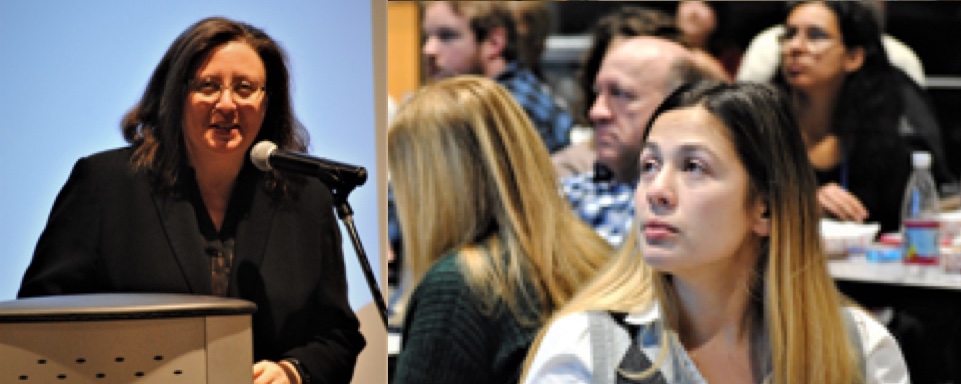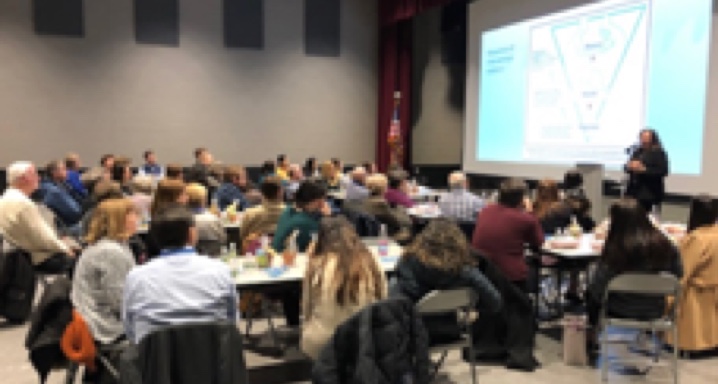DSABC Luncheon Highlights Anxiety Awareness
Mentors learn to recognize signs of stress
January 23, 2019

Today’s students are increasingly exposed to new realities from 24/7 technology to lockdown drills and conflicts over immigration. One result of these mounting pressures is a rise in childhood anxiety rates. But how do adults know when a child’s anxiety is more than just a response to everyday stress and may need to be addressed by a team of experts.
At the Danbury Schools and Business Collaborative (DSABC) annual mentor luncheon held at Danbury High School on January 23rd, mentors learned how to be aware of the signs of a student suffering with anxiety and how to alert appropriate experts. For one hour a week during the school year, hundreds of mentors volunteer with DSABC to support students who need an adult in their lives. While mentors aren’t charged with disciplining students or tutoring them, they can be one of the first people to notice when a child is struggling.
Keynote speaker Dr. Mary Murphy of Insight Counseling in Ridgefield focused her talk on recognizing varying degrees of anxiety in students.
Murphy said that anxiety is the most common emotional issue for children, citing statistics that 31.9 percent of children ages 13-18 are diagnosed every year with anxiety. She said because some families in Danbury are living in poverty with more than half of students qualifying for free or reduced lunch, and some are foreign born, life is very uncertain for many students and anxiety is quick to develop as a result.
“And because of school shootings, we have a whole new reality . . . they have to be in an emergency preparedness mode,” said Murphy, adding that, combined with other traumatic experiences, possible abuse or neglect included, these experiences can have a tremendous impact on a young person.
Elisa Pica, who is retired from Cartus Corporation in Danbury, has been a DSABC mentor for seven years with the same student. She found the presentation to be very helpful in recognizing the different stages of anxiety. In addition to differentiating between what can be considered general anxiety linked to a situation or clinical anxiety disorder, which can include obsessive-compulsive order and phobias, Murphy shared with mentors how to look for signs that students need help.
“I have known my student since she was in first grade. I tell her we are growing up together,” Pica said. “At every visit with her, I often look for changes, so Dr. Murphy’s presentation was very helpful and I learned more details about anxiety.”
Although most people, including children, experience some day-to-day anxiety that focuses on a specific situation, they can quickly move on after an event, such as an upcoming test. It’s when the worries don’t go away, if they interfere with functioning at school or at home, or if they result in physical symptoms or lead to avoidance behaviors like substance use or isolation, that the child may need some intervention.
“Anxiety is a great masquerader,” said Murphy, adding that often children with anxiety are diagnosed with other mental health conditions, making it difficult to determine the underlying cause. Special needs students also need different intervention strategies.
Mentors can be an invaluable resource for students because of the level of communication they develop with the student and can look for “red flags,”. While some anxiety is normal and a part of life, too much is not, Murphy said, and a mentor’s demeanor can make an enormous difference for the student.
“When we stay calm, we are modeling that behavior for them,” Murphy said. “Your presence is an intervention.”
Gary Bruce, Deputy Fire Marshal in Danbury and a mentor at Rogers Park Middle School since 2017, has long recognized the pressures that middle school students face.
“The presentation by Dr. Murphy was very helpful in identifying the differences between stress and anxiety,” Bruce said. “Her simple methods encourage open lines of communication. I enjoy being a mentor and supporting the students on their journey of life.”

